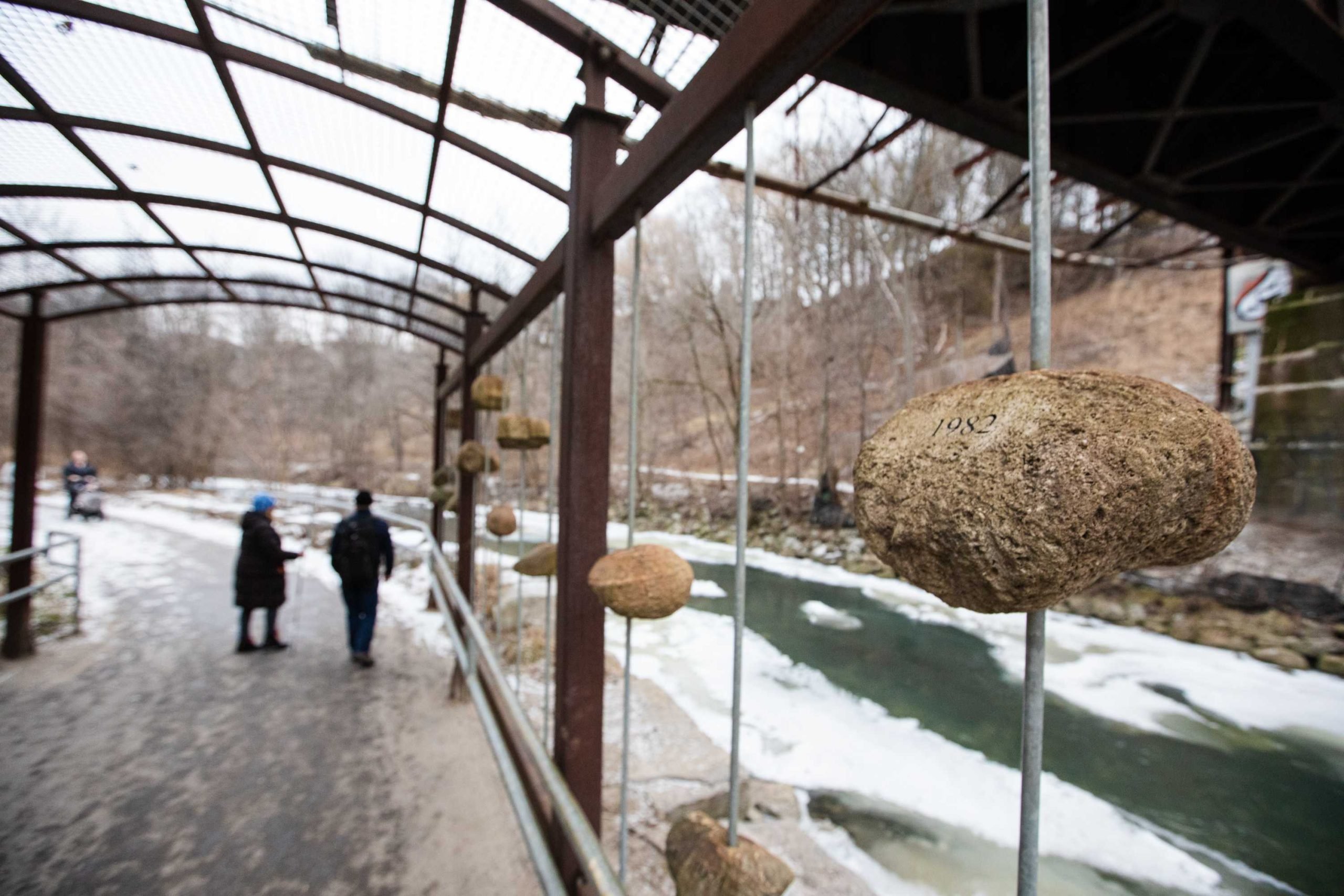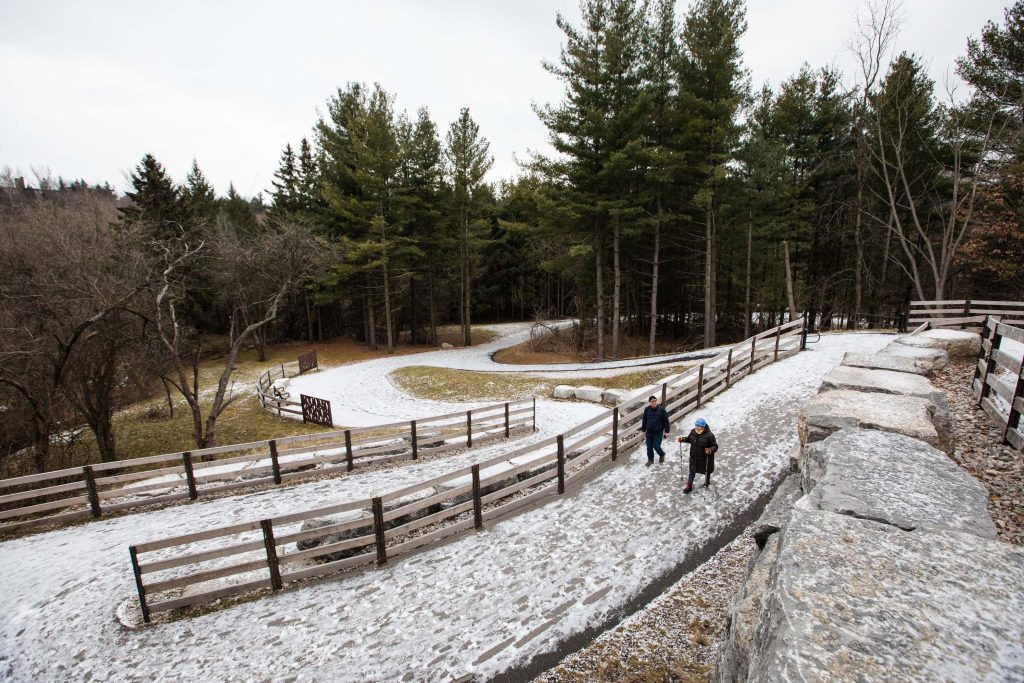
One of the things I’ve learned during the year-and-a-half I’ve been writing this occasional column is the vastness of the Don and Humber rivers. While I’ve written about the lower parts of both rivers in previous articles, I always knew I wanted to return and continue north.
So when musician, actor and arts educator Paula Wolfson suggested walking along a northeast patch of the Don River, I immediately said “Yes!” Also, Wolfson is a delightful person and I figured it would be lots of fun. I was right.
Start: Wednesday, 2:40 pm, Wigmore Park entrance
It’s hard to access Wigmore Park from public transit – the closest intersection is Eglinton and Victoria Park – but Wolfson graciously agreed to pick up me and photographer Nick Lachance at the Victoria Park subway station. We pack into her blue Honda, nicknamed “Fanny Fit,” and trek up north. The car seat is made of imitation grass – a nod to My Garden’s Keeper, which Wolfson has owned and operated for the past 18 years. We’ll get to that later.
The entrance to the park isn’t much. Wolfson, who lives nearby on Eglinton, discovered it because she kept seeing lots of cars parked next to it.
“I kept wondering, ‘Is somebody having a party?'” she says as she gets out her walking sticks and we prepare to go down a gentle slope into the Charles Sauriol Conservation Reserve.
I’ve packed my own trekking poles, but the paths seem pretty walkable; there’s not much ice on them.

We’ve barely walked half a kilometre when we run into Norm Reynolds, a writer, actor and teacher. He recognizes me from my Twitter photo (we follow each other) and he also recognizes Wolfson. Turns out the two once starred in a local musical based on Hamlet called Somethin’s Rockin In Denmark, adapted from a show called Kronberg 1582, which eventually became the short-lived Broadway musical Rockabye Hamlet. Footage of Somethin’s Rockin exists on YouTube.
“I recognize your impish little smile,” says Wolfson to Reynolds. “You were trouble, weren’t you?”
“Only if the director wanted me to be,” he replies, not missing a cue.
Wolfson performed in big sit-down and touring musicals like Beauty And The Beast and Les Misérables, and won a Dora Award for her role in the rock musical Shaking The Foundation.
Performing as a swing in a show like Les Mis, she had to know 16 female parts, each one with a different costume and mic pack change.
“I still have nightmares about being in the wrong place at the wrong time, and wearing the wrong hat,” she says.
Although she still performs occasionally – her solo Fringe show Judas Star Supersong was a revelation in 2018 – two decades ago she left theatre because, as she puts it, she couldn’t bear another summer stock experience.
“Learning choreography and lines in 10 days, including tech? Old chestnuts, and living in somebody’s basement? No thank you,” she says. A temporary job working for a landscape designer opened her eyes to a part of the industry where she could find a niche. The owner explained some gardens have been ignored for years, and Wolfson thought: “‘Oh, there’s my spot!’ I got my horticultural certificate from Guelph, put a sign on my car and an ad in the paper and off I went.”
My Garden’s Keeper was born. One of Wolfson’s favourite quotes has an arts connection.
“Gardening is one of the slowest of the performing arts,” she says. “It takes patience. Things don’t happen right away. It can take up to three years to make a new garden, then you can enjoy it for a couple of years before you go in and start renovating. It’s fantastic.”

As we descend to the pathway, any markers of where we are in North York disappear. It’s all nature, with the path winding between groups of trees. One zigzaggy path is partly bordered with big sturdy blocks of stone. Helpful railings have been constructed to prevent slipping.
We meet a dozen or so people on the trail, and everyone seems cheerful, happy to be outdoors in the winter.

A little further down are a series of rusted installations featuring cutouts of salmon – indicating the salmon that swim upstream to spawn every fall in the nearby Don River.
Last winter, Wolfson walked this trail every day. She’s sad the trees aren’t capped with snow; they look so much prettier, she says. Once, she entered the trail from another spot and ended up at a cliff, which just dropped off.
Charles Sauriol, after whom the reserve is named, co-founded the Don Valley Conservation Association in the 1940s. And you can see what attracted him to the area. You can hear birdsong constantly – “Is that a woodpecker?” Wolfson says a couple of times during our walk – and as the afternoon darkens we look up into the trees to see if we can spot any owls.

After a few minutes we come to a forest full of tall trees with ramrod straight and narrow trunks (pines?). We spy an entrance and decide to enter and soon come to the Don. The river is frozen over, and we see a group of mallards looking for food. Wolfson takes out some sunflower seeds and throws them onto the ice, and with remarkable accuracy the ducks peck them out.
Back on the trail, we come to a series of two stunning arched bridges that cross the river. They almost have an Asian appearance to them. They look recently built or renovated, and include sturdy aluminum railings to prevent people from slipping. I can see why Wolfson keeps returning to this trail. There’s something elemental about this view. A bridge literally gets you from one place to another – a comforting and soothing thought during a period like this.

“The first year of the pandemic, things got ridiculous with me eating and drinking whatever I wanted,” she says. “It couldn’t continue. I cried a lot. The walks helped.”
Then we come to one of the most famous features of the area: sculptor and photographer Robert Sprachman’s installation High Water Mark, which features 15 stones, each one attached to a rod and engraved with a year in which the Don flooded. The years range from 1886 to 1998, but the stone heights are only symbolic, they don’t indicate the water level.
A little further down, we approach the underpass of some train tracks. Wolfson says she wishes a train would pass by, and soon one does – just as we’re walking beneath it. We stare at each other. “Do you know that scene from Cabaret?” she asks me. Of course I do. As the cars rattle above, we shout and scream at the top of our lungs. The train’s a little too high to drown out our cries, but the experience is cathartic. Sally Bowles was onto something.

We also come to a section where people have left food out for the winter birds. Wolfson spots some cardinals and chickadees flying overhead. On a nearby stump someone’s poured oats and what looks like sugary breakfast cereal. A chickadee pecks away at it.
We could continue and eventually make it to the famous Rainbow Tunnel, visible to drivers going north on the Don Valley Parkway. But we’re getting tired and I need to find a restroom. So we head back.
End: 4:15 pm, Wigmore Park entrance
As Wolfson drops me off on Eglinton, she suggests another walking route in the future. “And we don’t have to talk about theatre!” she says. I also make a mental note to return when there’s more snow on the ground. There will be time. Canadian winters are long.
See more Pandemic Walks here












